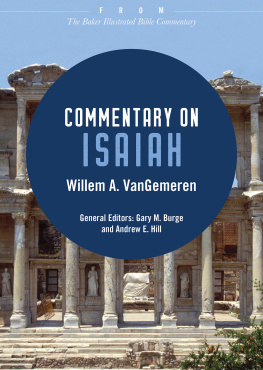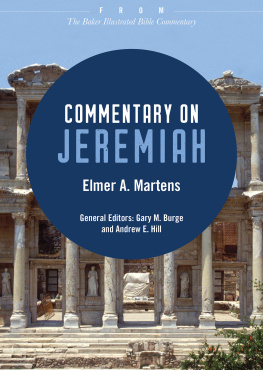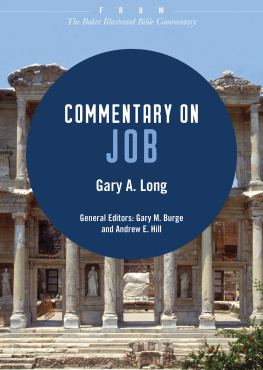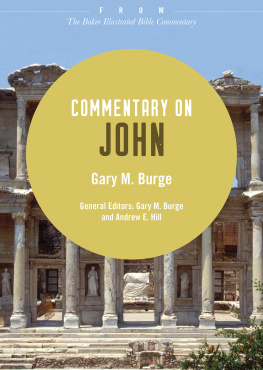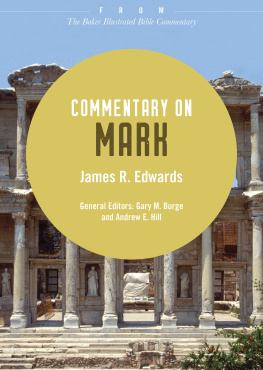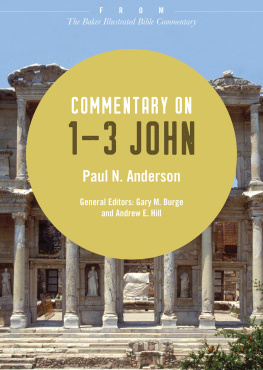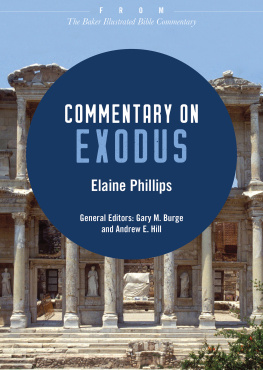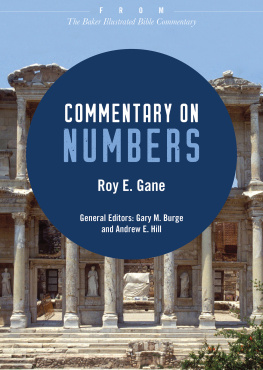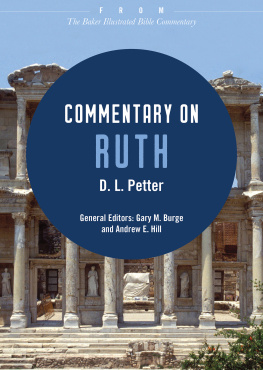David W. Pao - Commentary on Acts: From The Baker Illustrated Bible Commentary
Here you can read online David W. Pao - Commentary on Acts: From The Baker Illustrated Bible Commentary full text of the book (entire story) in english for free. Download pdf and epub, get meaning, cover and reviews about this ebook. year: 2019, publisher: Baker Publishing Group, genre: Religion. Description of the work, (preface) as well as reviews are available. Best literature library LitArk.com created for fans of good reading and offers a wide selection of genres:
Romance novel
Science fiction
Adventure
Detective
Science
History
Home and family
Prose
Art
Politics
Computer
Non-fiction
Religion
Business
Children
Humor
Choose a favorite category and find really read worthwhile books. Enjoy immersion in the world of imagination, feel the emotions of the characters or learn something new for yourself, make an fascinating discovery.
- Book:Commentary on Acts: From The Baker Illustrated Bible Commentary
- Author:
- Publisher:Baker Publishing Group
- Genre:
- Year:2019
- Rating:4 / 5
- Favourites:Add to favourites
- Your mark:
- 80
- 1
- 2
- 3
- 4
- 5
Commentary on Acts: From The Baker Illustrated Bible Commentary: summary, description and annotation
We offer to read an annotation, description, summary or preface (depends on what the author of the book "Commentary on Acts: From The Baker Illustrated Bible Commentary" wrote himself). If you haven't found the necessary information about the book — write in the comments, we will try to find it.
David W. Pao: author's other books
Who wrote Commentary on Acts: From The Baker Illustrated Bible Commentary? Find out the surname, the name of the author of the book and a list of all author's works by series.
Commentary on Acts: From The Baker Illustrated Bible Commentary — read online for free the complete book (whole text) full work
Below is the text of the book, divided by pages. System saving the place of the last page read, allows you to conveniently read the book "Commentary on Acts: From The Baker Illustrated Bible Commentary" online for free, without having to search again every time where you left off. Put a bookmark, and you can go to the page where you finished reading at any time.
Font size:
Interval:
Bookmark:
2012 by Baker Publishing Group
Published by Baker Books
a division of Baker Publishing Group
P.O. Box 6287, Grand Rapids, MI 49516-6287
www.bakerbooks.com
Ebook short created 2019
Previously published in The Baker Illustrated Bible Commentary edited by Gary M. Burge and Andrew E. Hill in 2012
All rights reserved. No part of this publication may be reproduced, stored in a retrieval system, or transmitted in any form or by any meansfor example, electronic, photocopy, recordingwithout the prior written permission of the publisher. The only exception is brief quotations in printed reviews.
Library of Congress Cataloging-in-Publication Data is on file at the Library of Congress, Washington, DC.
ISBN 978-1-4934-2467-2
Unless otherwise indicated, Scripture quotations are from the Holy Bible, New International Version. NIV. Copyright 1973, 1978, 1984, 2011 by Biblica, Inc. Used by permission of Zondervan. All rights reserved worldwide. www.zondervan.com. The NIV and New International Version are trademarks registered in the United States Patent and Trademark Office by Biblica, Inc.
Scripture quotations labeled ESV from The Holy Bible, English Standard Version (ESV), copyright 2001 by Crossway, a publishing ministry of Good News Publishers. Used by permission. All rights reserved. ESV Text Edition: 2007
Scripture quotations labeled NASB are from the New American Standard Bible, copyright 1960, 1962, 1963, 1968, 1971, 1972, 1973, 1975, 1977, 1995 by The Lockman Foundation. Used by permission. www.lockman.org
Scripture quotations labeled NIV 1984 are from the HOLY BIBLE, NEW INTERNATIONAL VERSION. NIV. Copyright 1973, 1978, 1984 by International Bible Society. Used by permission of Zondervan. All rights reserved.
Scripture quotations labeled NJPS are from the New Jewish Publication Society Version 1985 by The Jewish Publication Society. All rights reserved.
Scripture quotations labeled NKJV are from the New King James Version. Copyright 1982 by Thomas Nelson, Inc. Used by permission. All rights reserved.
Scripture quotations labeled NLT are from the Holy Bible , New Living Translation, copyright 1996, 2004, 2007 by Tyndale House. Used by permission of Tyndale House Publishers, Inc., Carol Stream, Illinois 60188. All rights reserved.
Scripture quotations labeled NRSV are from the New Revised Standard Version of the Bible, copyright 1989, by the Division of Christian Education of the National Council of the Churches of Christ in the United States of America. Used by permission. All rights reserved.
Scripture quotations labeled RSV are from the Revised Standard Version of the Bible, copyright 1952 [2nd edition, 1971] by the Division of Christian Education of the National Council of the Churches of Christ in the United States of America. Used by permission. All rights reserved.
Unless otherwise indicated, photos, illustrations, and maps are copyright Baker Photo Archive.
| ANET | Ancient Near Eastern Texts Relating to the Old Testament . Edited by J. B. Pritchard. 3rd ed. Princeton, 1969 |
| BDAG | Bauer, W., F. W. Danker, W. F. Arndt, and F. W. Gingrich. Greek-English Lexicon of the New Testament and Other Early Christian Literature. 3rd ed. Chicago, 1999 |
| ca. | circa (about, approximately) |
| cf. | compare |
| chap(s). | chapter(s) |
| COS | The Context of Scripture . Edited by W. W. Hallo. 3 vols. Leiden, 1997 |
| e.g. | for example |
| ESV | English Standard Version |
| HALOT | Koehler, L., W. Baumgartner, and J. J. Stamm. The Hebrew and Aramaic Lexicon of the Old Testament. Translated and edited under the supervision of M. E. J. Richardson. 5 vols. Leiden, 19942000 |
| HCSB | Holman Christian Standard Bible |
| i.e. | that is |
| KJV | King James Version |
| NASB | New American Standard Bible |
| NEB | New English Bible |
| NET | New English Translation |
| NIV | New International Version (2011 edition) |
| NIV 1984 | New International Version (1984 edition) |
| NJB | New Jerusalem Bible |
| NJPS | The Tanakh: The Holy Scriptures: The New JPS Translation according to the Traditional Hebrew Text |
| NKJV | New King James Version |
| NLT | New Living Translation |
| NRSV | New Revised Standard Version |
| RSV | Revised Standard Version |
| TDOT | Theological Dictionary of the Old Testament . Edited by G. J. Botterweck and H. Ringgren. Translated by J. T. Willis, G. W. Bromiley, and D. E. Green. 8 vols. Grand Rapids, 1974 |
| TNIV | Todays New International Version |
David W. Pao
Introduction
According to the modern versions of the New Testament, the Acts of the Apostles follows the four Gospels. This arrangement highlights the fact that Acts provides an account of the period following the life of Jesus the Messiah. As the second volume of the writings of Luke, however, Acts does not simply provide the historical account of growth of the church. It also testifies to the work of God through the apostles of Jesus, who continue to witness the power of the gospel as it fulfills the ancient promises made to Israel. In other words, instead of simply an appendix to the work of Jesus, this work points to yet another phase in the fulfillment of salvation history.

[ Copyright Baker Photo Archive. Courtesy of the Holyland Hotel, Jerusalem, 2001. Reproduction of the City of Jerusalem at the time of the Second Temple presently located at the Israel Museum, Jerusalem. ]
The Unity of Luke-Acts
Since the work of Henry Cadbury in the 1920s ( The Making of Luke-Acts ), most scholars recognize that Luke-Acts has to be read as two parts of a single work. This affirmation of the unity of Luke-Acts not only points to the need to interpret any one passage within the literary context of this wider narrative but also allows the reader to notice the numerous parallels between the two parts of the narrative. These parallels in turn reveal the theological emphases of the author, and these emphases often serve to address the needs of the church. In his Gospel, for example, Luke emphasizes the descent of the Holy Spirit on Jesus as he began his ministries on earth (Luke 3:2122). In Acts, Luke likewise draws attention to the descent of the Holy Spirit on the apostles as they began their ministries (Acts 2:113). Such parallelism addresses a practical concern of the church: Luke encourages the early Christians that, although Jesus is no longer with them in person, the Spirit, who works behind him, is the one who is working behind the church that bears his name.
Although some (e.g., Mikeal Parsons and Richard Pervo, Rethinking the Unity of Luke and Acts ) have continued to question the unity of Luke-Acts, most see this as the basic assumption behind any informed reading of the Lukan writings. In terms of genre, these two works are not simply representatives of the ancient biographies and histories; together they point to the faithful God who fulfills his promises to Israel. In terms of narrative flow, several themes introduced in Luke (e.g., Holy Spirit, Gentiles, repentance, Samaria/Samaritans, temple, rejection of the prophet) are fully developed only in Acts; therefore, to read only one part would provide a partial picture. In terms of theological framework, one finds the same emphases on significant theological topics: identity of Jesus, the mission of the apostles, the progression of the kingdom of God, the universal relevance of the gospel message. In terms of the use of Old Testament paradigms, both works also draw from one prophetic tradition in the description of the climactic work of God at the dawn of the eschatological era.
Font size:
Interval:
Bookmark:
Similar books «Commentary on Acts: From The Baker Illustrated Bible Commentary»
Look at similar books to Commentary on Acts: From The Baker Illustrated Bible Commentary. We have selected literature similar in name and meaning in the hope of providing readers with more options to find new, interesting, not yet read works.
Discussion, reviews of the book Commentary on Acts: From The Baker Illustrated Bible Commentary and just readers' own opinions. Leave your comments, write what you think about the work, its meaning or the main characters. Specify what exactly you liked and what you didn't like, and why you think so.



